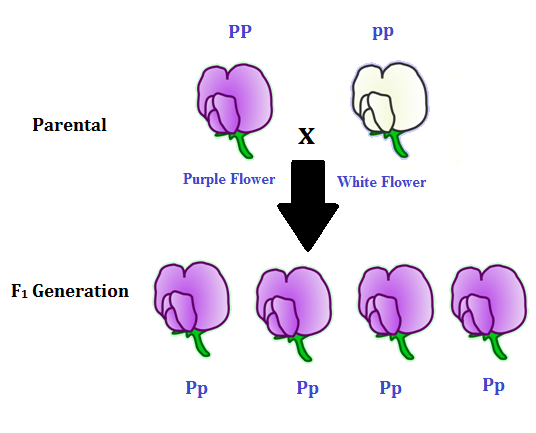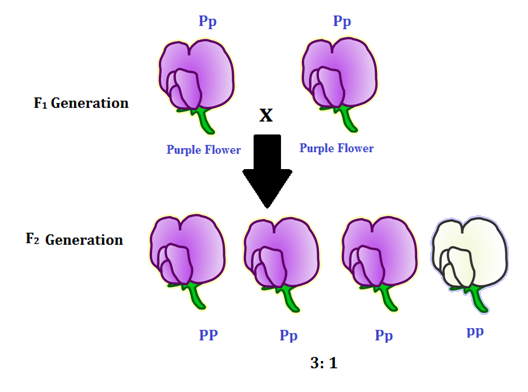The mystery of genetics was unlocked during the mid-nineteenth century by Gregor Mendel. He conducted an experiment on pea plants by cultivating pea plants and observing the pattern of inheritance in different stages of generation.
Mendel is the Father of genetics. He proposed three laws- Law of Independent Assortment, Law of Dominance, and Law of Segregation. These laws came into existence by experiments on pea plants with a variety of traits.
Mendel investigated the pairs of pea plants with one contrasting trait. Mendel studied the following seven characters with contrasting traits:
- Flower colour: Violet/white
- Flower position: Axial/terminal
- Pod colour: Green/yellow
- Pod shape: Inflated/constricted
- Seed colour: Yellow/green
- Seed shape: Round/wrinkled
- Stem height: Tall/dwarf
He crossed two homozygous individuals, which resulted in heterozygous offspring. This was known as the monohybrid cross.
Monohybrid Cross Definition
“A monohybrid cross is the hybrid of two individuals with homozygous genotypes which result in the opposite phenotype for a certain genetic trait.”
“The cross between two monohybrid traits (TT and tt) is called a Monohybrid Cross.”
Monohybrid cross is responsible for the inheritance of one gene. It can be easily shown through a Punnett Square.
Monohybrid cross is used by geneticists to observe how homozygous offspring express heterozygous genotypes inherited from their parents.
How To Carry Out A Monohybrid Cross?
The ratios of the phenotype and the genotype that are estimated are only probabilities. Listed below are steps that can be used to calculate a monohybrid cross:
- Indicate the alleles using characters – recessive alleles can be indicated by lower case letters while dominant alleles can be indicated by upper case letters
- Note down both the phenotype and the genotype of the parents or the parental generation that are being crossed
- Jot down the genotype of the gametes from the parental generation – As a result of meiotic division, the gametes will be haploid
- Tabulate a Punnett square to chalk out the probable combinations of the gametes – Any combination is possible as the process of fertilization is random
- The phenotype and the genotype ratios of the prospective offspring can be written. The outcome hence obtained is known as the F1 generation. The F2, F3 etc generations form the subsequent generations.
Monohybrid Cross Example
Gregor Mendel’s Peas
For monohybrid cross, Mendel began with a pair of pea plants with two contrasting traits, i.e., one tall and another dwarf. The cross-pollination of tall and dwarf plants resulted in tall plants. All the hybrid plants were tall. He called this as a first hybrid generation (F1) and offspring were called Filial1 or F1 progeny.
He conducted an experiment with all seven contrasting pairs and observed that the entire F1 progeny showed one pattern in their behaviour, i.e., they resembled one of the parents. Another parent character was completely absent.

Monohybrid Cross
He continued his experiment with self-pollination of F1 progeny plants. Surprisingly, he observed that one out of four plants were dwarf while the other three were tall. The tall and the short plants were in the ratio of 3:1.
He also noted that no progeny was in intermediate height, i.e., no blending was observed. The result was the same for other traits of plants too, and he called them second hybrid generation and the offspring were called Filial2 or F2 progeny.

Mendel observed that traits which were absent in F1 generation had reappeared in the F2 generation. He called such suppressed traits as recessive traits and expressed traits as dominant traits. He also concluded that some ‘factors’ are inherited by offspring from their parent over successive generations.
Later, these ‘factors’ were called genes. Genes are responsible for the inheritance of traits from one generation to another. Genes consist of a pair of alleles which code for different traits. If a pair of alleles is the same, i.e., TT or tt, such alleles are called homozygous pair while those that are different or non-identical (e.g. Tt) are called heterozygous pair.
Huntington’s Disease
Huntington’s diseases is a fatal genetic disorder. The Huntingtin gene, responsible for Huntington’s disease is present in all the individuals.
The homozygous dominant Huntingtin gene of an individual was paired with the homozygous recessive Huntingtin gene of another individual. All the offspring carried the dominant allele for Huntington’s disease. That means that the child will have this disease.
Confirming Dominant Traits
In the first step of a monohybrid cross, the homozygous traits of an individual are crossed. In the next step, when the heterozygous traits are crossed, it is confirmed whether the trait is dominant or recessive.
Dihybrid and Test Cross
There are two types of breeding processes to know the mechanism of genes and examine the inheritance of traits from parents and grandparents, one is monohybrid cross and the other is dihybrid cross. The latter occurs when the F1 generation offspring differ in two traits. It is a cross between two entities that are heterozygous for two different traits. Mendel carried out the following experiment for this cross:
- For crossing, he took a pair of contradicting characteristics or traits
- Mendel crossed round-yellow seed and wrinkled-green seed
- In the F1 generation, the outcome was seeds that were round and yellow
- The F1 generation indicated that the round and yellow traits are dominant while the green colour and the wrinkled shape were recessive traits.
- Self-pollination of F1 progeny resulted in four varying combinations of seeds in the subsequent generation, the F2 generation.
- The outcome and the dihybrid cross-ratio were – round-yellow, wrinkled-yellow, wrinkled-green, round-green and the ratio was – 9:3:3:1.
A testcross is a cross that involves mating with a genotype that is unknown with a known genotype, a homozygous recessive genotype.
A homozygous recessive genotype is crossed because of the following:
- In the presence of dominant alleles, the effects of recessive alleles are always masked
- Thereby, the phenotype of the offspring exhibits the genotype of the unknown parent.
Purpose of test cross: They are used to determining if a dominant phenotype is heterozygous or homozygous
Learn more about monohybrid cross, its definition, example and other related biology concepts at BYJU’S.
Read Also:
Frequently Asked Questions
What is a monohybrid cross?
A monohybrid cross is a genetic mix between two individuals with homozygous genotypes which result in an opposite phenotype.
What is the difference between monohybrid and dihybrid?
The monohybrid and a dihybrid cross can be differentiated on the basis of the number of traits being studied in the offspring. In a monohybrid cross, the inheritance of a single gene is predicted because the parents are homozygous whereas in a dihybrid cross the parents differ in two different traits.
What is a test cross?
A test cross is the breeding of an individual with a recessive individual. It was introduced by Gregor Mendel. It is done to determine the zygosity of the former by analyzing the proportions of offspring phenotypes.
What is a dihybrid cross?
A dihybrid cross is a cross between two different genes that differ in their observed traits. It is a cross between two individuals that are heterozygous for two different traits.
Give an example of a monohybrid cross.
Breeding a long-stemmed pea plant with a short-stemmed pea plant is an example of a monohybrid cross. A cross between the two creates heterozygous offspring.
What is a monohybrid ratio?
A monohybrid ratio is the phenotypic ratio of different types of individuals occurring in the F2 generation of a monohybrid cross. The Mendelian monohybrid ratio is 3:1.
What are pure gametes?
Pure gametes are the gametes that are haploid. The gametes are always pure and do not possess homologous chromosomes. Instead, they possess one chromosome of each type, either recessive or dominant.

Excellent understanding matter
It explains in the best way for everything each and every formula, definition, numerical, etc I love it